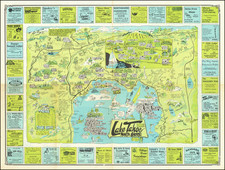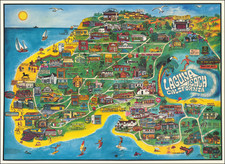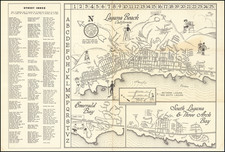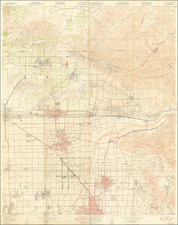The Gem of the Continent
Rare Promotional Broadsheet plan of Redondo Beach, California, issued by the Redondo Beach Company and lithographed by Britton & Rey in San Francisco.
This would seem to be the original promotional broadsheet map for Redondo Beach, published by the original promoter. While not all of the streets shown still exist, unlike many of these first promotional town plans, Redondo Beach's future development proceeded on an almost identical path.
A caption in lower left corner notes "Redondo Beach Co., capital: $3,000,000". The title on the veso describes Redondo as "The gem of the continent" above large pictorial inset of Hotel Redondo.
At the center is the site of the Hotel Redondo, with 3 bath houses along the beach to the south. To the north, of the Hotel is the Plaza and large Y shapped Ship Landing and Boat Landing. Off the coast, contour lines illustrate the depth of the water, illustrating the suitabilty of the PIer for shipping commerce. Adjacent to the landing to the north, a Railroad Freight Depot, Passenger Depot and Railroad Yards appear directly adjacent to the Bathing Pool, a curious mix of recreation and heavy industry. Further north is the large lake "Las Salinas," with a boat house shown. Several other Church sites are shown, along with twin reservoirs.
At the center of the town, a Chautauqua Assembly Pavillion is shown, a badge of Redondo's future respectability. Chautauqua was an adult education and social movement in the United States, highly popular in the late 19th and early 20th centuries. Chautauqua assemblies expanded and spread throughout rural America until the mid-1920s. The Chautauqua brought entertainment and culture for the whole community, with speakers, teachers, musicians, showmen, preachers, and specialists of the day. Former U.S. President Theodore Roosevelt was quoted as saying that Chautauqua is "the most American thing in America.
Redondo Beach
As noted by Glen Creason:
[Redondo Beach] was founded in 1887 when the Dominguez family sold off 434 acres of beachfront property from the former Spanish land grant Rancho San Pedro for $12,000. The land went to a group of developers . . . finally landing in the hands of Captain J.C. Ainsworth and R.R. Thompson. Ainsworth and Thompson managed a fleet of steamers, and after seeking port in Redondo, they used their eye for industry to build the area up.
1887 also happened to be the year when the Santa Fe and Southern Pacific railroads waged a rate war, thus drawing thousands of newbies out to Los Angeles and setting off a population and real estate boom. Redondo was primed for development . . . . it held the possibility of being a resort and as well as a deep-water port. Speculators bought up the land in hopes it could be both a place that would open Los Angeles up to shipping riches and act as a sun-soaked paradise known as “the gem of the continent.”
A great, 225-room hotel was built in 1889 (the Miramar, then the Redondo Hotel), and plans for railroad lines connecting Redondo to close-by Los Angeles added to increased interest. In 1892, Redondo Beach was incorporated with a great salt water bathing pool, bath houses, a couple of reservoirs, an old fashioned plaza, and an intricate street layout with the east/west roads being named after precious stones (beryl, amethyst, agate, diamond etc.) and the north/south roads with girl’s names mostly drawn from the Dominguez family tree (Benita, Elena, Francisca, Gertruda, Irena, Lucia, etc).
The map also shows the amazing Salt Lake, a 200’ by 600’ spring-fed body of salt water just 200 yards from the ocean. “La Esplanada” was a street along the shore set aside for invigorated strolling. At that time, the port enjoyed great success, especially in the shipping of lumber for use in the big city.
Rarity
OCLC locates copies of this map at the Huntington Library and California Historical Society.
The Huntington Library also holds a larger version of the map ( about 40 x 26 inches).












![[Santa Cruz & Santa Clara Counties] Denny's Pocket Map of Santa Cruz County, California. Compiled From the Latest and Official Data . . . `1916](https://storage.googleapis.com/raremaps/img/small/80637.jpg)



